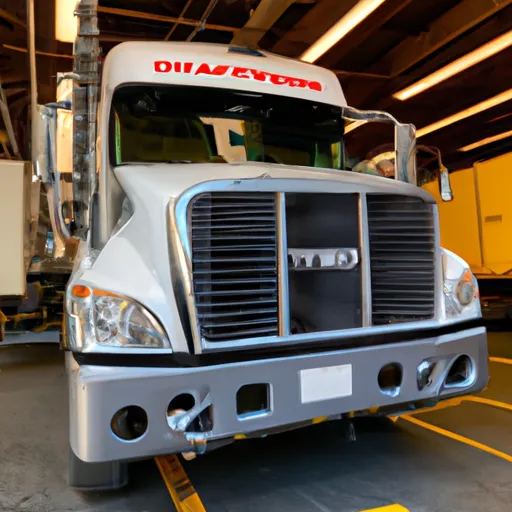
Everything You Need to Know About Freightliner Transmission Cooler: Installation, Maintenance, and Upgrades
What is a Freightliner Transmission Cooler and How Does it Work?
In this chapter, we will cover the basics of a Freightliner Transmission Cooler, including what it is, why it’s important, and how it works. A transmission cooler is a component that helps regulate the temperature of the transmission fluid by dissipating heat generated during the transmission’s operation. It works by passing the transmission fluid through a series of tubes that are cooled by either air or liquid.
There are different types of transmission coolers available, including air-cooled, liquid-cooled, and fan-assisted coolers. Air-cooled coolers use airflow to cool the fluid, while liquid-cooled coolers use a coolant to transfer the heat away from the transmission fluid. Fan-assisted coolers combine the benefits of both air and liquid cooling, using both airflow and a coolant to cool the fluid.
Overall, understanding the basics of a Freightliner Transmission Cooler and how it works is essential to understanding the importance of maintaining it and identifying when it needs to be repaired or replaced.
Signs of a Faulty Freightliner Transmission Cooler
In this chapter, we’ll discuss the signs that indicate your Freightliner Transmission Cooler may be faulty. There are several signs to look out for, including:
-
Overheating: If the temperature of the transmission fluid is consistently higher than normal, it could be a sign that the transmission cooler is not functioning properly.
-
Leaking: If you notice fluid leaking from the transmission cooler, it could be a sign that there is a crack or damage to the cooler.
-
Reduced transmission performance: If you experience slipping or poor shifting when driving, it could be a sign that the transmission fluid is not being cooled properly.
-
Burnt smell or discolored fluid: If the transmission fluid smells burnt or appears discolored, it could be a sign that the transmission is overheating due to a faulty cooler.
It’s important to address any of these signs immediately to prevent further damage to your transmission. Continuing to drive with a faulty transmission cooler can lead to expensive repairs or even the need for a full transmission replacement.
How to Install a Freightliner Transmission Cooler
In this chapter, we’ll provide a step-by-step guide on how to install a Freightliner Transmission Cooler. Before beginning the installation process, it’s important to gather all necessary tools and equipment, including the new transmission cooler, mounting hardware, and transmission fluid.
The installation process typically involves the following steps:
-
Locate the existing transmission cooler and remove it if necessary.
-
Install the new transmission cooler in the same location as the old one, making sure to use the mounting hardware provided.
-
Connect the transmission cooler lines to the new cooler and secure them with the provided fittings.
-
Fill the transmission with fluid and start the engine, allowing it to run for a few minutes to circulate the new fluid through the system.
-
Check for any leaks or issues with the installation, and make any necessary adjustments.
It’s important to follow the manufacturer’s instructions carefully and to double-check all connections to ensure that the new transmission cooler is installed correctly. If you’re unsure about any step of the installation process, it’s recommended to seek the assistance of a professional mechanic.
Maintenance Tips for Your Freightliner Transmission Cooler
In this chapter, we’ll provide some helpful tips on how to maintain your Freightliner Transmission Cooler to ensure it continues to function properly and extend its lifespan.
-
Regularly inspect the transmission cooler for any signs of damage or leaks. If you notice any issues, address them immediately to prevent further damage.
-
Keep the transmission cooler clean by removing any dirt, debris, or bugs that may accumulate on the surface. This can be done using a soft brush or compressed air.
-
Check the transmission fluid level regularly and top it up as needed. Low fluid levels can cause the transmission to overheat, putting additional strain on the cooler.
-
Use high-quality transmission fluid that is recommended by the manufacturer. This can help prolong the lifespan of the transmission and the cooler.
-
Consider upgrading your transmission cooler if you frequently tow heavy loads or live in an area with high temperatures. Upgraded coolers can provide better cooling performance and prevent overheating.
By following these maintenance tips, you can help ensure that your Freightliner Transmission Cooler continues to function properly and avoid costly repairs or replacements in the future.
Upgrading Your Freightliner Transmission Cooler: What You Need to Know
In this chapter, we’ll discuss the benefits of upgrading your Freightliner Transmission Cooler and what you need to know before making the upgrade.
Upgrading your transmission cooler can provide several benefits, including:
-
Improved cooling performance: Upgraded coolers can dissipate heat more effectively, which can help prevent overheating and extend the lifespan of your transmission.
-
Increased towing capacity: If you frequently tow heavy loads, an upgraded cooler can provide the additional cooling performance needed to prevent damage to your transmission.
-
Enhanced durability: Upgraded coolers are often constructed with higher-quality materials that can withstand more wear and tear over time.
Before making the upgrade, it’s important to consider the following factors:
-
Compatibility: Make sure the upgraded cooler is compatible with your specific Freightliner model and transmission type.
-
Installation: Upgraded coolers may require additional installation steps or modifications to your vehicle, so make sure you have the necessary tools and expertise.
-
Cost: Upgraded coolers can vary in price, so make sure to choose one that fits within your budget.
Overall, upgrading your Freightliner Transmission Cooler can provide significant benefits and improve the overall performance and durability of your vehicle. Just be sure to consider the compatibility, installation, and cost before making the upgrade.
For detailed information, you can contact us at torqueusa.com.


